esporos/spores
Randee Silv
April 2016
I cry out in the dream, but I know that I am dreaming, and over both sides of the dream,
I make my will prevail.
– Antonin Artaud, Mexico 1936

The work is about perception and awareness. What we call reality is the strangest fantasy of all. Reality is a constantly moving notion depending on the point of view of the watcher. We discover that what we call reality is just an accumulation of mysteries.
Here, the painting with its double face is like a testimony that leads the observer to become aware of the gaze of others, showing that the ways of looking and seeing are various and can be connected. Perception is realized through our senses and feelings, and to perceive is to build a world, and there are a lot of imaginable constructions.
A painting is two sided: one side is identified as belonging to a world of representation and the other one being beyond appearances, the vital energy. The way of looking at all the living things around us is infinite, because the experiences we acquire constantly modify our perception and understanding of the world.
Perception – Discoveries – Understanding – Catherine Henke
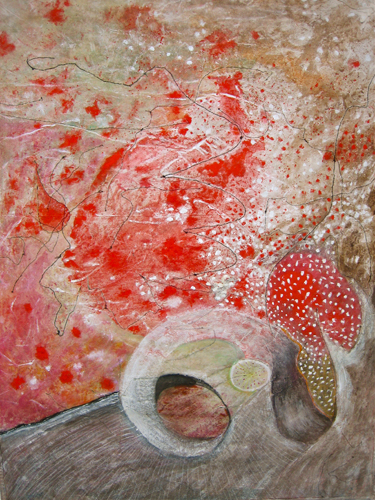
I talked with Swiss artist Catherine Henke about her recent exhibition, esporos/spores, at the Galeria Municipal de Montemor-o-Novo in Portugal. Catherine moved in 1976 from Geneva to this small agricultural city, where she is part of an active international arts community.
Catherine, in the catalogue for the exhibition, you’d written that spores is the outcome of your research on fungi and that the mushroom is a microcosm of the whole Earth, the cosmic force which allows a visionary experience: the world of forms and the world of mind. Can you talk more about these ideas and how they evolved into this new body of work?
I wanted this project to be closely linked to the earth, tellus mater; dark, malleable, receptive and maternal, fertile, regenerative, that holds within it the diversity of all the seeds, spores, microorganisms and roots that exist in our world. It is full of life. In order to talk about tellus mater, I decided to focus on the fungus amanita muscaria, an ephemeral organism born in the humus that it produces. Without earth, there are no mushrooms, no seeds, or life… so the earth is the context where things are happening. In a nearby cork forest, various amanita muscaria mushrooms were discovered, and they appeared as a gift to me. While this type of mushroom is plentiful in the northern latitudes, it is less frequent in the area where I live. An unworked soil is needed, and you have to arrive at the right place at the right moment because mushrooms don’t last for very long. Siberian shamans use this gorgeous red amanita speckled with white flakes to modify their perceptions and enter into a trance. It is also the mushroom of fairy tales and the sign of a magical world, so I began by making drawings of the amanita.
When drawing these magical mushrooms, did any unexpected surprises surface?
At first I was just drawing these amanitas hoping to capture their beauty while they were still fresh. As they began to dry, their form and colors quickly changed. But then I felt something similar to how they might appear in shamanistic practices or in fairy tales as if they were a symbol telling us WOW! you are now entering into a magical world. I knew I needed to continue in this direction of developing work on double-sided surfaces, where there is the possibility of two ways of expression on the same canvas.
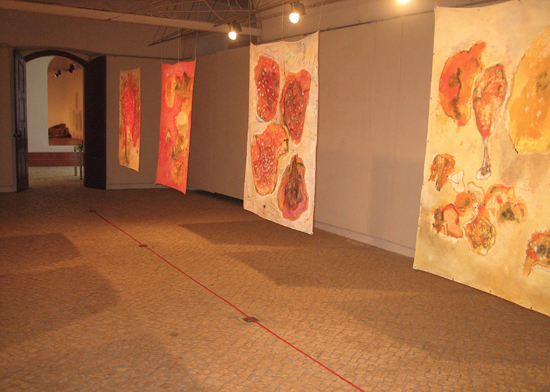
By hanging your paintings from the ceiling in the middle of the gallery, you’ve created this dialogue with the space, a rhythm, a moving engagement, a crossing of boundaries. Imagery can be seen on both sides of the paintings. Are these mirrored compositions? Were they planned or did all this happen by chance?
Yes, these mirrored compositions were planned. It is another way to go through the looking–glass, the glass where I’m seeing my seeing. The fresh and dried mushrooms are part of one world, and on the other side is the sacred or magical world. This is a continuation of a way of working on the canvas that I’d been previously involved with. As I painted images on one side, traces of these drawings appeared on the other side that created dream like imagery.
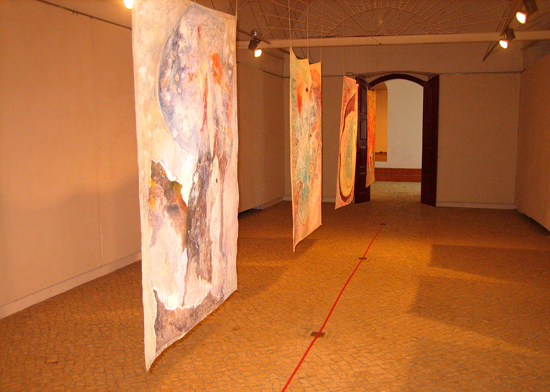
When I first look at these two photographs showing the paintings from front and back, I don’t immediately see the connection of one side to the other. They each appear as if they are two completely separate paintings. But then when I look at them longer, I begin to sense that each side is responding to the other, provoking another stroke, debating another gesture, rethinking where the paint should be placed, contemplating what visual form it wants to take. You must have felt like the third voice in the conversation almost as if you were documenting what each side wanted to reveal.
Yes. The connection between the two sides is not immediate, and sure, they appear as different paintings, different realities, different worlds. You have some graphic elements, the color passing onto the other side, the seams, the eyelets existing on both sides; but the real connection is the amanita, the magic mushroom. The paintings are only juxtaposed in this way through the photography, but it’s not that the paintings are like Magritte painting a pipe and writing that this is not a pipe. What I guess we can feel is that, from the first side, the side of representation to the other one, there is a kind of explosion, a cosmic explosion, taking the borders off of the object. I like this way of calling me the third voice, the interpreter of this complicated dialogue (interaction). It is a position similar to the one of the shaman but in a different context. The artist is the third voice who creates a relation between two worlds by resolving a third one. This could be the design of the installation, the purpose of which would be to perturb the observer for a second.
Yes, to perturb the viewer, even for only a second. Viewers need to be jolted, to think in other modes. Maybe as they’re gazing at your work, another way of seeing the world around them will be experienced, a shift in consciousness, an inner transition, how to enter into other spaces.
You made it clear. This concept will maybe make the observer act and be more conscious of this moment, here and now.
The paintings cast these amazing shadows on both the floor and walls. Was this intentional?
I also love the shadows too, but it really wasn’t intentional. While doing the installation for the exhibition, I was concentrating on how to create an optical illusion so that upon entering you only see lines of red. I had to figure out where to put the lights so that there wouldn’t be any transparency from either side of the paintings. When these technical issues were resolved, the shadows just appeared. They seem to be showing us that the room isn’t empty. They almost look like the frame that the canvases don’t have!
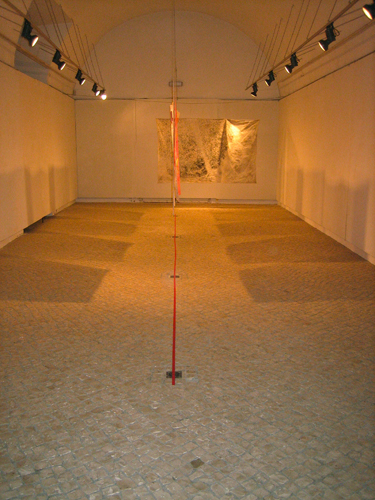
When you set up the exhibition, did you have a particular plan in mind for how you wanted the audience to experience your work?
In the middle of the gallery, there are 4 large paintings (90 x 120 cm), titled perspectives recto/verso, that are suspended from the ceiling. This way, the viewer is able to clearly see the imagery on both sides. I wanted to create the feeling that when you enter the room it seems almost empty and that you don’t see the paintings at first but there is a thin vertical red line that can be seen from their profile. There is another red line, a horizontal one on the floor that is underneath the paintings that acts as a division between two worlds, one of representation and the other that is beyond appearances, the vital energy. I wanted the viewer to see both of these lines, the one that divides the vertical space and the other along the horizontal plane. The red is the dominant color. The color of the amanita. At the back of the room, there’s a large black and white piece (240 x 150 cm), spores preserver, that has been painted by nature, marked by molds that I’ve only retouched to emphasize certain areas. On the other side in a smaller room, I’ve placed a mixed media installation, a landscape. In the exhibition I wanted there to be a lot of empty space. Like the silences in music. It’s a wink to John Cage, his zen spirit and his passion for mushrooms!

The patterning and imagery in spores preserver is really fascinating. Is the mold still growing?
Yes, it’s an interesting pattern made by nature. This was a piece of fabric that was covering a tank of water, and by being outside in the humidity, molds naturally formed. I had put the fabric in my house, and when I later came across it and saw the imagery that appeared on both sides, I realized it had to be in my show about spores. All I did was to intensify the black color in some parts. The mold seems to me that it’s still getting more intense in some places and that the fabric is getting weaker and more transparent.
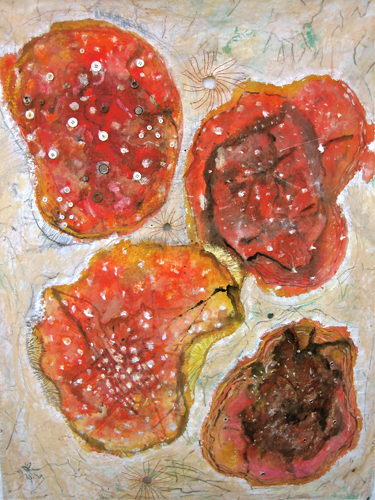
How else did you capture a sense of transition from one side into the other, the visible into the invisible?
I’ve sewn lines of thread onto the fabric that have become a series of little holes. I’ve made even larger holes by cutting, some for the eyelets and some where I’ve sewn on buttons, all of which represents a ritual way of communication. The seams and holes act as thresholds giving access to another world while keeping a memory of the other side. Two indivisible paintings, but impossible to be seen together. The passage between one world and the other can only be done through these openings. The spectator can just cross the red line to the other side. In this way, he is losing the first side. When I’m painting, I’m painting on the wall and can’t go to the other side. I have to turn the painting from side to side constantly, and these holes give me a more direct passage. The sewn lines can also be seen as drawn lines that give a different meaning that acknowledges both sides. Sometimes they seem very evident and sometimes they almost disappear.
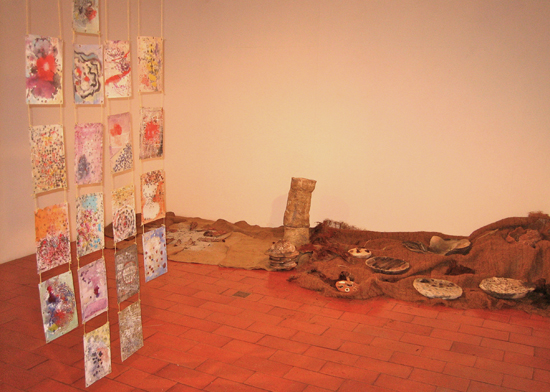
In the smaller adjacent room, you’ve made a landscape with fabric, clay objects and ash from a wood fire. Can you tell us more about this installation?
It’s just an encounter, like when you are walking in the forest and come across different things. First I thought about putting earth directly on the floor, to put the ceramics and the remnants of the fire on it; but as it was raining here a lot, the earth was so wet, heavy and full of grass, that it couldn’t really be used; so I transfigured this idea by using a variety of fabrics, like coco fiber and jute, to represent different colors and textures of earth.
Fire belongs to the everyday work of the countryside. It is a way of life. It is the basic element for heat in the winter. It is used in catching the olives and for cooking food. I included a small pile of remnants left from a burning fire, very similar to what I see every morning in our hearth, that I had made from paper paste molded in cork. In the shamanic world, fire means purification, renovation, fluidity, perception, light, mobility — and smoke is a vehicle for accessing the spiritual world.
The clay objects are made from sandstone and were fired in an electric kiln, and the second firing was in a recycled metal container where sawdust was added and left to slowly burn for about 24 hours. In doing this type of firing, marks from the smoke were left on the clay pieces. These objects convey notions of sprouting, blossoming, perishing, and germinating related to the mushrooms, seeds and tree barks. On the fabrics I also put some vegetal elements: the skin of a serpent (an allusion to the cosmic snake) and objects molded from the bark of cork trees found in the Montado forestry area.
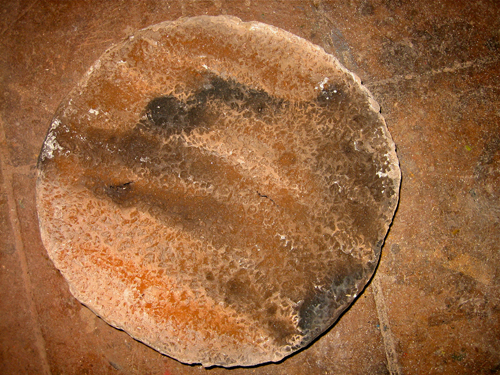
The Montado landscape is quite beautiful; farming mixed in with fields of cork trees and animals grazing.
Yes, there are many areas with this landscape close to where I live that I go to often. The Montado is an ecosystem specific to the Alentejo, an agro-silvo-pastoral system whose dominant species is the cork oak. It is one example of a European sustainable use of soil. The economic value of the Montado is related to the production of cork, but also to farming, honey production, hunting and mushroom picking. The Montado is an important cultural reference regarding biodiversity preservation, historical social systems, traditional agriculture and landscape preservation.
And the smaller paintings, spores, near the landscape installation, what was the inspiration for these?
Each painting (19 x 26 cm) represents a different collection of spores that had once floated in the atmosphere before falling into the humus where they will start their cycle of reproduction again. Spores are basically an invisible powder, so I imagined what I thought they might look like. There is always a part of fiction when you build a fantasy world!
Jeremy Narby, can you talk about his influence on your work?
When a friend told me of Jeremy Narby and his work researching the shaman’s knowledge, I saw a connection between my work and his research. I became very interested in his way of procuring answers. In his book, The Cosmic Serpent, DNA and the Origins of Knowledge, we again find the crossing of the two worlds; a primitive knowledge and a scientific one, two very different perspectives. Jeremy talks about how the shaman’s ancestral knowledge is acquired through trances in direct contact with nature. He writes: “The plant that cured the potentially mortal bite of the jergón snake has a pair of white hooks resembling the snake fangs. We know this thanks to these hooks, because that is the sign that nature gives.”
The shaman as a healer knows and maintains the balance between the sacred and profane worlds, and, as a cosmic transformer, communicates with the invisible, with the supernatural, through dreams and the waking dream. To dream with eyes wide open is also an artistic method, which is close to the mystical journey of the shaman and ecological knowledge. Some art practices emphasize research as an ethical position in the world. The shaman has the power to communicate with different levels of reality close to nature by perceiving tiny elements of life but also by seeing beyond. Being clairvoyant, the shaman can communicate with the invisible, the supernatural. The shaman creates the links between these two worlds, which I have been exploring in my paintings.
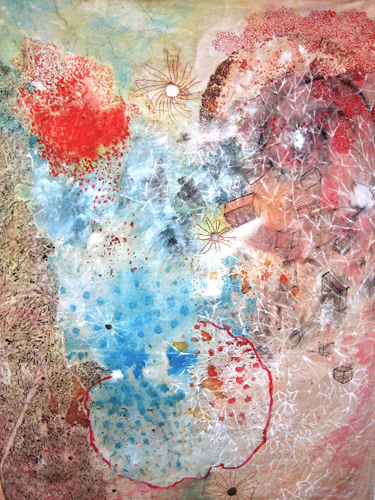
“To dream with eyes wide open is also an artistic method.” How does that play into your own art practice?
When I’m painting, I will sit a long time in front of the paintings and just look at them, no matter what phase they are in, often with my eyes half open. It’s like entering into a dream that gives insights for directions I might take.
You’ve titled your large paintings, perspectives/recto/verso, what meaning does that have for you?
perspectives/recto/verso means that I’m presenting my work in two different ways. It’s experimentation with how you can represent an object. Perspective is the aspect presented by an object from the place where we look at it.
How did the viewers respond to this presentation of two different worlds? Do you feel that they understood what they were looking at? Did they run by too quickly? Or did they take time to contemplate the ideas you were addressing?
At the opening, I did explain that reality is a constantly moving notion depending of the viewpoint of the observer, and by viewpoint I mean ideology, context, experience, time, way of life and so on. People said that they really liked my explanation, that it was clear and made sense. I think that many people already have this type of consciousness, but when they confront it in this exhibition there are still the possibilities of surprises. People would stay for quite a while passing from one room to the other, reading the text.
I think that this way of using both sides of the canvas has not been used much in painting. You have the 2 sides of a page in a book, the 2 sides of a banner, for example. For me, it is very important for explaining our world as an assemblage of parallel realities. Here only 2, because the canvas has only 2 sides!
You’ve put a lot of thought into how to present this relationship between these two worlds. Do you feel you were successful in accomplishing what you set out to do?
Hopefully. Nothing is ever perfect, so we always have the possibility of further pursuing our ideas and insights. I worked quite a bit on the concept and with how to set up this installation. I think that how I shaped the content strengthens the plastic expression. There are still things that I want to develop more precisely in my next project in a different context. New ideas are emerging. Now let’s see how they congeal.
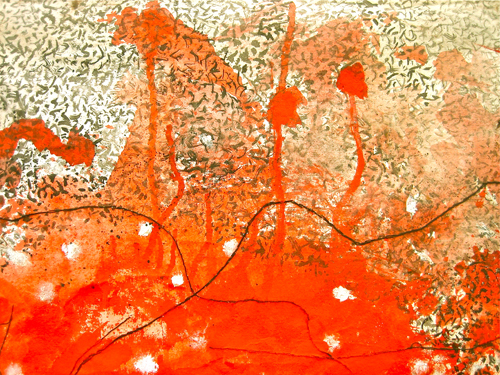
When we are dreaming and, as often happens, have a dim consciousness of the fact and try to wake, do we not say and do things which in waking life would be insane? May we not then sometimes define insanity as an inability to distinguish which is the waking and which the sleeping life? We often dream without the least suspicion of unreality. “Sleep hath its own world” and it is often as lifelike as the other. – from Lewis Carroll’s Diaries
Is all our Life, then, but a dream
Seen faintly in the golden gleam
Athwart Time’s dark resistless stream?
from Lewis Carroll’s Sylvie and Bruno
You can read Traces, the 2014 interview I did with Catherine about her work

One mark of the true artist is the humility to be amazed.
Clearly the article expresses Catherine’s original diligence in documenting the beauty of the forms burgeoning into new realizations.
The only disappointment is not being able to see the works in person.
It was so illuminating to hear Henke’s discussion of what she was trying to do with this work, and I so appreciated your photos which succeeded in capturing some of the entering and discovering the way the work was placed in the space. As it happens I recently saw an exhibit at the Berkeley Art Museum called “The Architecture of Life” which also pondered forms of the natural world but focused very much on amazing structures; it was wonderful to see the way Henke saw the forms as windows to a journey of consciousness. Infinite perspectives. Truly enchanting.
Beautiful work and an absolutely fascinating read. I’m sure the work is even more impactful to see in person, but you’ve both brought it to life in this fabulous interview.